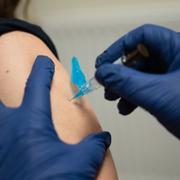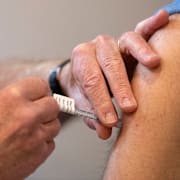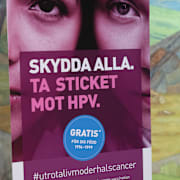bakgrund
Humant papillomvirus
Wikipedia (en)
Human papillomavirus infection (HPV infection) is caused by a DNA virus from the Papillomaviridae family. Many HPV infections cause no symptoms and 90% resolve spontaneously within two years. In some cases, an HPV infection persists and results in either warts or precancerous lesions. These lesions, depending on the site affected, increase the risk of cancer of the cervix, vulva, vagina, penis, anus, mouth, tonsils, or throat. Nearly all cervical cancer is due to HPV and two strains – HPV16 and HPV18 – which account for 70% of cases. HPV16 is responsible for almost 90% of HPV-positive oropharyngeal cancers. Between 60% and 90% of the other cancers listed above are also linked to HPV. HPV6 and HPV11 are common causes of genital warts and laryngeal papillomatosis.An HPV infection is caused by the human papillomavirus, a DNA virus from the papillomavirus family. Over 200 types have been described. An individual can become infected with more than one type of HPV, and the disease is only known to affect humans. More than 40 types may be spread through sexual contact and infect the anus and genitals. Risk factors for persistent infection by sexually transmitted types include early age of first sexual intercourse, multiple sexual partners, smoking, and poor immune function. These types are typically spread by sustained direct skin-to-skin contact, with vaginal and anal sex being the most common methods. HPV infection can also spread from a mother to baby during pregnancy. There is no evidence that HPV can spread via common items like toilet seats, but the types that cause warts may spread via surfaces such as floors. HPV is not killed by common hand sanitizers and disinfectants, increasing the possibility of the virus being transferred via non-living infectious agents called fomites.HPV vaccines can prevent the most common types of infection. To be most effective, inoculation should occur before the onset of sexual activity, and are therefore recommended between the ages of 9–13 years. Cervical cancer screening, such as the Papanicolaou test ("pap smear"), or examination of the cervix after applying acetic acid, can detect both early cancer and abnormal cells that may develop into cancer. Screening allows for early treatment which results in better outcomes. Screening has reduced both the number of cases and the number of deaths from cervical cancer. Genital warts can be removed by freezing.Nearly every sexually active individual is infected by HPV at some point in their lives. HPV is the most common sexually transmitted infection (STI), globally. High-risk HPVs cause about 5% of all cancers worldwide, with an estimated 570,000 women and 60,000 men getting an HPV-related cancer each year. In the United States, about 36,000 cases of cancer due to HPV occur each year. Cervical cancer is among the most common cancers worldwide, causing an estimated 604,000 new cases and 342,000 deaths in 2020. About 90% of these new cases and deaths of cervical cancer occurred in low- and middle-income countries. Roughly 1% of sexually active adults have genital warts. Cases of skin warts have been described since the time of ancient Greece, but that they were caused by a virus was not determined until 1907.




